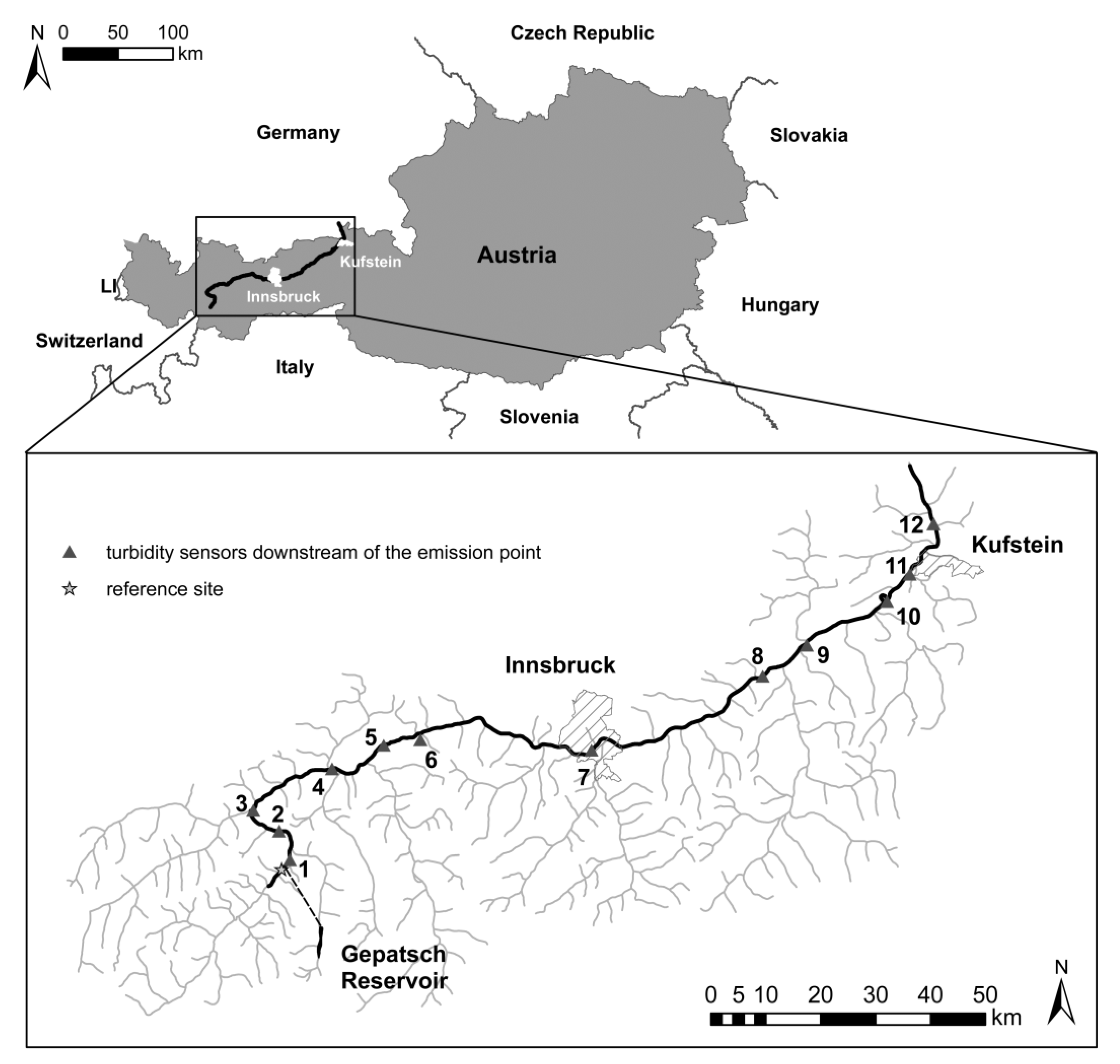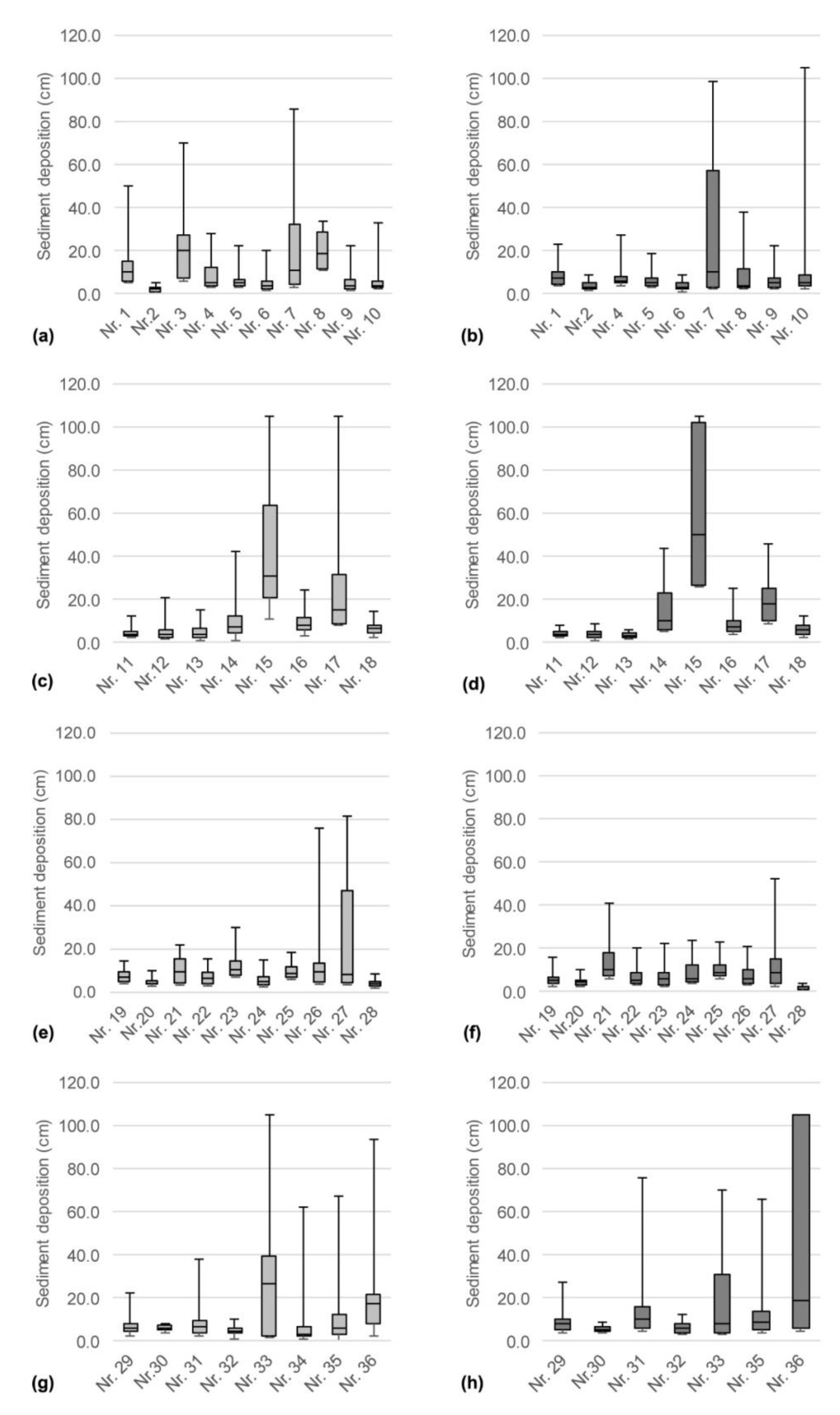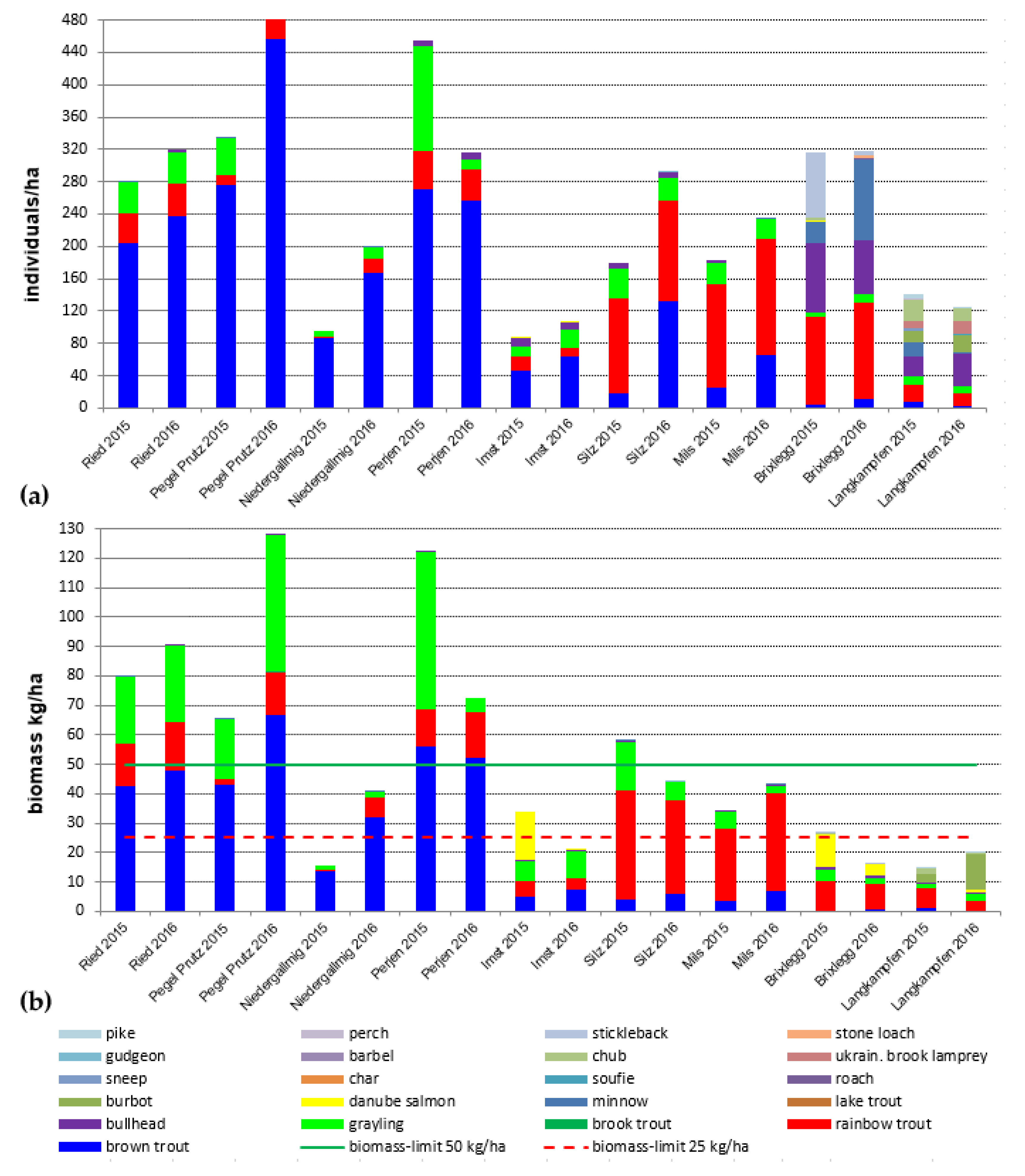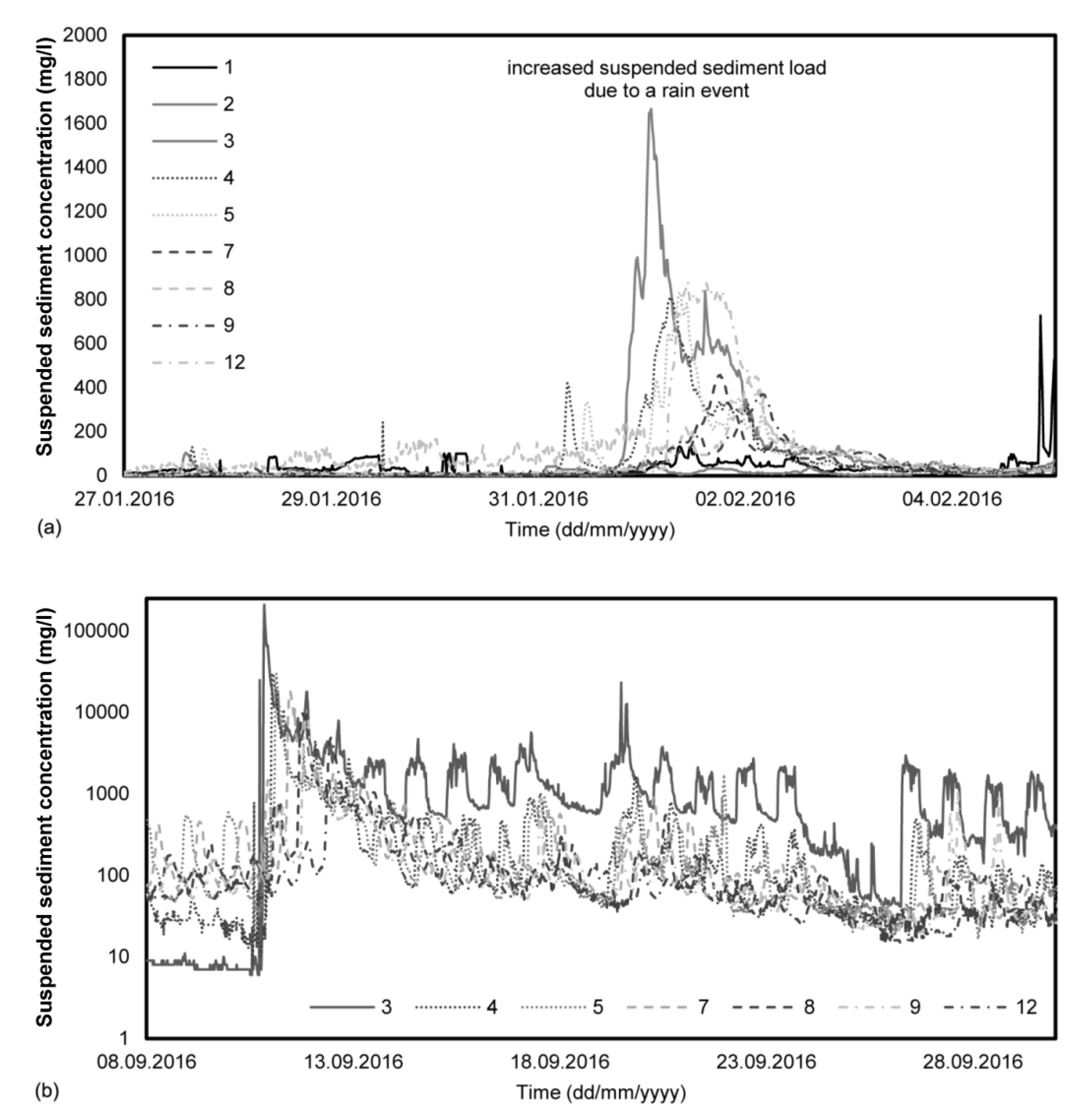Controlled Reservoir Drawdown—Challenges for Sediment Management and Integrative Monitoring: An Austrian Case Study—Part A: Reach Scale
Abstract
:1. Introduction
2. Materials and Methods
2.1. Case Study
2.2. Monitoring Concept
2.3. Reach Scale
2.3.1. Continuous Monitoring of SSCs: Turbidity Measurements
[(QRIED × SSCRIED) + (QTAILRACE HPP PRUTZ × SSCTAILRACE HPP PRUTZ)]/(QRIED + QTAILRACE HPP PRUTZ)
SSCTAILRACE HPP PRUTZ × (QHPP PRUTZ + QCOOLING WATER) + SSCRIED × (QPRUTZ – QHPP PRUTZ – Q COOLING WATER)
[Q PRUTZ × (SSCTARGET [1000 mg/l] − SSCRIED) + QCOOLING WATER × (SSCTARGET [1000 mg/l] − SSCRIED)] / [SSCTAILRACE HPP PRUTZ − SSCRied]
2.3.2. Fine Sediment Deposits on Gravel Bars
2.3.3. Mapping and Analysis at Salmonid Spawning Sites
2.3.4. Fish—Abundance and Biomass
2.3.5. Tributary Analysis
3. Results
3.1. Suspended Sediment Concentrations and Sediment Transport
3.2. Fine sediment deposits on gravel bars
3.3. Mapping and Analysis at the Salmonid Spawning Sites
3.4. Fish
3.5. Tributary Analysis
4. Discussion
5. Conclusions
Author Contributions
Funding
Conflicts of Interest
References
- Hauer, C.; Wagner, B.; Aigner, J.; Holzapfel, P.; Flödl, P.; Liedermann, M.; Tritthart, M.; Sindelar, C.; Pulg, U.; Klösch, M.; et al. State of the art, shortcomings and future challenges for a sustainable sediment management in hydropower: A review. Renew. Sustain. Energy Rev. 2018, 98, 40–55. [Google Scholar] [CrossRef]
- Einsele, G.; Hinderer, M. Terrestrial sediment yield and the lifetimes of reservoirs, lakes, and larger basins. Geol. Rundsch. 1997, 86, 288–310. [Google Scholar] [CrossRef]
- Basson, G. Sedimentation and Sustainable Use of Reservoirs and River Systems; International Commission on Large Dams: Paris, France, 2010. [Google Scholar]
- Tolouie, E.; West, J.R.; Billam, J. Sedimentation and desiltation in the SeÞd-Rud reservoir, Iran. In Geomorphology and Sedimentology of Lakes and Reservoirs; McManus, J., Duck, W., Eds.; Wiley: New York, NY, USA, 1993; pp. 125–138. [Google Scholar]
- Tamburino, V.; Barbagallo, S.; Vella, P. Evaluation of sediment deposition in Sicilian artificial Hydrology in Mountainous Regions: Artificial reservoirs. Water Slopes 1990, 2, 113. [Google Scholar]
- Takasu, S. Hydraulic design and model tests on a sediment release facility of the Unazuki dam. In Proceedings of the Fourteenth International Congress on Large Dams, Rio de Janeiro, Brazil, 3–7 May 1982. [Google Scholar]
- Butcher, D.P.; Labadz, J.C.; Potter, A.W.R.; White, P. Reservoir sedimentation rates in the southern Pennine region. In Geomorphology and Sedimentology of Lakes and Reservoirs; McManus, J., Duck, R.W., Eds.; John Wiley & Sons: Chichester, UK, 1993; pp. 73–92. [Google Scholar]
- Haeberli, W.; Beniston, M. Climate change and its impacts on glaciers and permafrost in the Alps. Ambio 1998, 27, 258–265. [Google Scholar]
- Annandale, G.W. Reservoir Sedimentation; John Wiley & Sons, Ltd.: Hoboken, NJ, USA, 2006. [Google Scholar]
- Gunatilake, H.M.; Gopalakrishnan, C. The economics of reservoir sedimentation: A case study of Mahaweli reservoirs in Sri Lanka. Int. J. Water Resour. Dev. 1999, 15, 511–526. [Google Scholar] [CrossRef]
- Kondolf, G.M.; Gao, Y.; Annandale, G.W.; Morris, G.L.; Jiang, E.; Zhang, J.; Cao, Y.; Carling, P.; Fu, K.; Guo, Q.; et al. Sustainable sediment management in reservoirs and regulated rivers: Experiences from five continents. Earth’s Future 2014, 2, 256–280. [Google Scholar] [CrossRef]
- Ligon, F.K.; Dietrich, W.E.; Trush, W.J. Downstream ecological effects of dams. BioScience 1995, 45, 183–192. [Google Scholar] [CrossRef]
- Poff, N.L.; Hart, D.D. How Dams Vary and Why It Matters for the Emerging Science of Dam Removal. BioScience 2002, 52, 659–668. [Google Scholar] [CrossRef] [Green Version]
- Rabení, C.F.; Doisy, K.E.; Zweig, L.D. Stream invertebrate community functional responses to deposited sediment. Aquat. Sci. 2005, 67, 395–402. [Google Scholar] [CrossRef]
- Alavian, V.; Jirka, G.H.; Denton, R.A.; Johnson, M.C.; Stefan, H.G. Density currents entering lakes and reservoirs. J. Hydraul. Eng. 1992, 118, 1464–1489. [Google Scholar] [CrossRef]
- Chen, Q.; Gerritsen, M.G.; Kovscek, A.R. Effects of reservoir heterogeneities on the steam-assisted gravity-drainage process. SPE Reserv. Eval. Eng. 2008, 11, 921–932. [Google Scholar] [CrossRef]
- Sumi, T.; Okano, M.; Takata, Y. Reservoir sedimentation management with bypass tunnels in Japan. In Proceedings of the 9th International Symposium on River Sedimentation, Yichang, China, 18–21 October 2014; pp. 1036–1043. [Google Scholar]
- Auel, C.; Boes, R.M. Sediment bypass tunnel design–review and outlook. In Dams under Changing Challenges; Schleiss, A.J., Boes, R.M., Eds.; Taylor & Francis Group: London, UK, 2011; pp. 403–412. [Google Scholar]
- Auel, C.; Kobayashi, S.; Takemon, Y.; Sumi, T. Effects of sediment bypass tunnels on grain size distribution and benthic habitats in regulated rivers. Int. J. River Basin Manag. 2017, 15, 433–444. [Google Scholar] [CrossRef]
- Petz-Glechner, R.; Patzner, A.; Jagsch, A. Wassertrübe und Fische—Auswirkungen resuspendierter Sedimente aus Speichern auf die Regenbogenforelle (Oncorhynchus mykiss). Schr. Forsch. Verb. 1999, 57, 1–130. [Google Scholar]
- Wilber, D.H.; Clarke, D.G. Biological effects of suspended sediments: A review of suspended sediment impacts on fish and shellfish with relation to dredging activities in estuaries. N. Am. J. Fish. Manag. 2001, 21, 855–875. [Google Scholar] [CrossRef]
- Crosa, G.; Castelli, E.; Gentili, G.; Espa, P. Effects of suspended sediments from reservoir flushing on fish and macroinvertebrates in an alpine stream. Aquat. Sci. 2010, 72, 85–95. [Google Scholar] [CrossRef]
- Scheurer, T.; Molinari, P. Experimental floods in the River Spöl, Swiss National Park: Framework, objectives and design. Aquat. Sci. 2003, 65, 183–190. [Google Scholar] [CrossRef]
- Martín, E.J.; Doering, M.; Robinson, C.T. Ecological assessment of a sediment by-pass tunnel on a receiving stream in Switzerland. River Res. Appl. 2017, 33, 925–936. [Google Scholar] [CrossRef]
- Serrana, J.M.; Yaegashi, S.; Kondoh, S.; Li, B.; Robinson, C.T.; Watanabe, K. Ecological influence of sediment bypass tunnels on macroinvertebrates in dam-fragmented rivers by DNA metabarcoding. Sci. Rep. 2018, 8, 1–10. [Google Scholar] [CrossRef]
- Robinson, C.T.; Uehlinger, U.; Monaghan, M.T. Effects of a multi-year experimental flood regime on macroinvertebrates downstream of a reservoir. Aquat. Sci. 2003, 65, 210–222. [Google Scholar] [CrossRef] [Green Version]
- Robinson, C.T.; Uehlinger, U.; Monaghan, M.T. Stream ecosystem response to multiple experimental floods from a reservoir. River Res. Appl. 2004, 20, 359–377. [Google Scholar] [CrossRef]
- Graham, A.A. Siltation of stone-surface periphyton in rivers by clay-sized particles from low concentrations in suspension. Hydrobiologia 1990, 199, 107–115. [Google Scholar] [CrossRef]
- Parkhill, K.L.; Gulliver, J.S. Effect of inorganic sediment on whole-stream productivity. Hydrobiologia 2002, 472, 5–17. [Google Scholar] [CrossRef]
- Noack, M.; Ortlepp, J.; Wieprecht, S. An approach to simulate interstitial habitat conditions during the incubation phase of gravel-spawning fish. River Res. Appl. 2016, 33, 192–201. [Google Scholar] [CrossRef]
- Extence, C.A.; Chadd, R.P.; England, J.; Dunbar, M.J.; Wood, P.J.; Taylor, E.D. The assessment of fine sediment accumulation in rivers using macro-invertebrate community response. River Res. Appl. 2013, 29, 17–55. [Google Scholar] [CrossRef]
- Wood, P.J.; Armitage, P.D. Biological effects of fine sediment in the lotic environment. Environ. Manag. 1997, 21, 203–217. [Google Scholar] [CrossRef]
- Berg, L.; Northcote, T.G. Changes in territorial, gill-flaring, and feeding behavior in juvenile coho salmon (Oncorhynchus kisutch) following short-term pulses of suspended sediment. Can. J. Fish. Aquat. Sci. 1985, 42, 1410–1417. [Google Scholar] [CrossRef]
- Newcombe, C.P.; Jensen, J.O. Channel suspended sediment and fisheries: A synthesis for quantitative assessment of risk and impact. N. Am. J. Fish. Manag. 1996, 16, 693–727. [Google Scholar] [CrossRef]
- Pulg, U.; Barlaup, B.T.; Sternecker, K.; Trepl, L.; Unfer, G. Restoration of spawning habitats of brown trout (Salmo trutta) in a regulated chalk stream. River Res. Appl. 2013, 29, 172–182. [Google Scholar] [CrossRef]
- Haun, S.; Kjærås, H.; Løvfall, S.; Olsen, N.R.B. Three-dimensional measurements and numerical modelling of suspended sediments in a hydropower reservoir. J. Hydrol. 2013, 479, 180–188. [Google Scholar] [CrossRef]
- Brierley, G.J.; Fryirs, K.A. Geomorphology and River Management: Applications of the River Styles Framework; John Wiley & Sons: Hoboken, NJ, USA, 2013. [Google Scholar]
- Olive, L.J.; Rieger, W.A. Stream suspended sediment transport monitoring-why, how and what is being measured. In Proceedings of the Oslo Symposium IHAS, Erosion and Sediment Transport Monitoring Programmes in River Basins, Olso, Norway, 24–28 August 1992; pp. 245–254. [Google Scholar]
- Walling, D.E.; Moorehead, P.W. The particle size characteristics of fluvial suspended sediment: An overview. Hydrobiologia 1989, 176, 125–149. [Google Scholar] [CrossRef]
- Skolasinska, K.; Nowak, B. What factors affect suspended sediment concentration in rivers? A study of the upper Warta River (Poland). River Res. Appl. 2018, 43, 112–123. [Google Scholar] [CrossRef]
- Brignoli, M.L.; Espa, P.; Batalla, R.J. Sediment transport below a small alpine reservoir desilted by controlled flushing: Field assessment and one-dimensional numerical simulation. J. Soils Sediments 2017, 17, 2187–2201. [Google Scholar] [CrossRef]
- Espa, P.; Brignoli, M.L.; Crosa, G.; Gentili, G.; Quadroni, S. Controlled sediment flushing at the Cancano Reservoir (Italian Alps): Management of the operation and downstream environmental impact. J. Environ. Manag. 2016, 182, 1–12. [Google Scholar] [CrossRef] [PubMed]
- Wen Shen, H. Flushing sediment through reservoirs. J. Hydraul. Res. 1999, 37, 743–757. [Google Scholar] [CrossRef] [Green Version]
- Haun, S.; Olsen, N.R.B. Three-dimensional numerical modelling of reservoir flushing in a prototype scale. Int. J. River Basin Manag. 2012, 10, 341–349. [Google Scholar] [CrossRef]
- Esmaeili, T.; Sumi, T.; Kantoush, S.A.; Kubota, Y.; Haun, S.; Rüther, N. Three-Dimensional Numerical Study of Free-Flow Sediment Flushing to Increase the Flushing Efficiency: A Case-Study Reservoir in Japan. Water 2017, 9, 1–22. [Google Scholar] [CrossRef] [Green Version]
- Schletterer, M.; Hofer, B.; Obendorfer, R.; Hammer, A.; Hubmann, M.; Schwarzenberger, R.; Boschi, M.; Haun, S.; Haimann, M.; Holzapfel, P.; et al. Integrative monitoring approaches for the sediment management in Alpine reservoirs: Case study Gepatsch (HPP Kaunertal, Tyrol). In Proceedings of the 13th International Symposium on River Sedimentation (ISRS), Stuttgart, Germany, 19–22 September 2016; Wieprecht, S., Haun, S., Weber, K., Noack, M., Terheiden, K., Eds.; 2017; pp. 1161–1169. [Google Scholar]
- Huss, M.; Farinotti, D.; Bauder, A.; Funk, M. Modelling runoff from highly glacierized alpine drainage basins in a changing climate. Hydrol. Process. 2008, 22, 3888–3902. [Google Scholar] [CrossRef]
- Heugens, E.H.; Hendriks, A.J.; Dekker, T.; Straalen, N.M.V.; Admiraal, W. A review of the effects of multiple stressors on aquatic organisms and analysis of uncertainty factors for use in risk assessment. Crit. Rev. Toxicol. 2001, 31, 247–284. [Google Scholar] [CrossRef]
- Atkinson, E. The Feasibility of Flushing Sediment from Reservoirs; Overseas Development Unit of HR Wallingford: Wallingford, UK, 1996; Available online: http://eprints.hrwallingford.co.uk/111/ (accessed on 6 April 2020).
- Lauffer, H. Das Kaunertalkraftwerk; Österreichische Wasserwirtschaft; Springer: Berlin/Heidelberg, Germany, 1968; pp. 129–144. [Google Scholar]
- Schöber, J.; Hofer, B. The sediment budget of the glacial streams in the catchment area of the Gepatsch reservoir in the Ötztal alps in the period 1965—2015. In Proceedings of the ICOLD 2018, Vienna, Austria, 1–7 July 2018; p. 20. [Google Scholar]
- Baumgartner, A.; Rienessel, C. Wasserkraft & Flexibilität—Der Beitrag der alpinen Wasserkraft zum Gelingen der Energiewende. Report on Behalf of the Arbeitsgemeinschaft Alpine Wasserkraft. 2019, p. 102. Available online: http://www.alpine-wasserkraft.com/ (accessed on 26 March 2020).
- Fernandes, J.N.; Boes, R.M.; Titzschkau, M.; Hammer, A.; Haun, S.; Schletterer, M. Sediment load, hydro-abrasive erosion and efficiency changes at high-head turbines during the drawdown of two Alpine reservoirs via the power waterway. In Proceedings of the HYDRO 2016—Hydropower and Dams, International Conference and Exhibition, Montreux, Switzerland, 10–12 October 2016; Available online: https://www.hydropower-dams.com/product/hydro-2016-event-proceedings/ (accessed on 26 March 2020).
- Haun, S.; Hauer, C.; Schletterer, M. Monitoring strategies to investigate suspend-ed sediments and turbine abrasion during the controlled drawdown of a hydropower reservoir. In Proceedings of the 5th Particles in Europe conference (PiE-2016), Budapest, Hungary, 3–5 October 2016; Available online: http://www.sequoiasci.com/about/pie/ (accessed on 26 March 2020).
- Espa, P.; Batalla, R.J.; Brignoli, M.L.; Crosa, G.; Gentili, G.; Quadroni, S. Tackling reservoir siltation by controlled sediment flushing: Impact on downstream fauna and related management issues. PLoS ONE 2019, 14. [Google Scholar] [CrossRef]
- Muhar, S.; Muhar, A.; Siegrist, D.; Egger, G. Rivers of the Alps—Diversity in Nature and Culture; Haupt Verlag: Bern, Switzerland, 2019; Available online: https://books.google.at/books/about/Rivers_of_the_Alps.html (accessed on 6 April 2020).
- BMLFUW. Schwebstoffe im Fließgewässer—Leitfaden zur Erfassung des Schwebstofftransportes; Bundesministerium für Land- und Forstwirtschaft, Umwelt und Wasserwirtschaft: Vienna, Austria, 2017. [Google Scholar]
- Hauer, C.; Holzapfel, P.; Flödl, P.; Wagner, B.; Graf, W.; Leitner, P.; Holzer, G.; Haun, S.; Habersack, H.; Schletterer, M. Controlled reservoir drawdown—Challenges for sediment management and integrative monitoring: An Austrian case study—Part B: Local Scale. Water 2020. in print. [Google Scholar]
- Felix, D.; Albayrak, I.; Boes, R.M. In-situ investigation on real-time suspended sediment measurement techniques: Turbidimetry, acoustic attenuation, laser diffraction (LISST) and vibrating tube densimetry. Int. J. Sediment Res. 2018, 33, 3–17. [Google Scholar] [CrossRef]
- Felix, D.; Albayrak, I.; Boes, R.M. Continuous measurement of suspended sediment concentration: Discussion of four techniques. Measurement 2016, 89, 44–47. [Google Scholar] [CrossRef]
- Schoellhamer, D.H.; Wright, S.A. Continuous Measurement of Suspended-Sediment Discharge in Rivers by Use of Optical Backscatterance Sensors. In Proceedings of the IHAS; pp. 28–36. Available online: https://pubs.er.usgs.gov/publication/70024677 (accessed on 3 April 2020).
- Edwards, T.K.; Glysson, G.D. Field Methods for Measurement of Fluvial Sediment. U.S. Geological Survey, Techniques of Water-Resources Investigations, Book 3: 1999. Available online: https://pubs.usgs.gov/twri/twri3-c2/ (accessed on 6 April 2020).
- Haun, S.; Rüther, N.; Baranya, S.; Guerrero, M. Comparison of real time suspended sediment transport measurements in river environment by LISST instruments in stationary and moving operation mode. Flow Meas. Instrum. 2015, 41, 10–17. [Google Scholar] [CrossRef]
- Shapiro, S.S.; Wilk, M.B. An analysis of variance test for normality (complete samples). Biometrika 1965, 52, 591–611. [Google Scholar] [CrossRef]
- Levene, H. Robust tests for equality of variances. In Contributions to Probability and Statistics, Essays in Honor of Harold Hotelling; Olkin, I., Ghurye, S.G., Eds.; Stanford University Press: Stanford, CA, USA, 1960; pp. 278–292. [Google Scholar]
- Kondolf, G.M. Assessing salmonid spawning gravel quality. Trans. Am. Fish. Soc. 2000, 129, 262–281. [Google Scholar] [CrossRef]
- Haunschmid, R.; Schotzko, N.; Petz-Glechner, R.; Honsig-Erlenburg, W.; Schmutz, S.; Unfer, G.; Wolfram, G.; Bammer, G.V.; Hundritsch, L.; Prinz, H.; et al. Leitfaden zur Erhebung der biologischen Qualitätselemente, Teil A1–Fische; Bundesministerium für Land- und Forstwirtschaft, Umwelt und Wasserwirtschaft: Vienna, Austria, 2015; p. 98. [Google Scholar]
- Schmutz, S.; Eberstaller, G.Z.J.; Jungwirth, M. Die »Streifenbefischungsmethode«: Eine Methode zur Quantifizierung von Fischbeständen mittelgroßer Fließgewässer. Österreichs Fischerei 2001, 54, 14–27. [Google Scholar]
- BAW. Fischökologische Leitbilder des Inn (Stand Juli 2010). Available online: www.baw.at (accessed on 9 December 2015).
- Amt der Tiroler Landesregierung. Tiris—Tiroler Rauminformationssystem. Available online: http://tiris.tirol.gv.at/ (accessed on 9 December 2015).
- Hauer, C.; Unfer, G.; Holzapfel, P.; Haimann, M.; Habersack, H. Impact of channel bar form and grain size variability on estimated stranding risk of juvenile brown trout during hydropeaking. Earth Surf. Process. Landf. 2014, 39, 1622–1641. [Google Scholar] [CrossRef]
- Obendorfer, R.; Hofer, B.; Bol, A. Underwater maintenance works in the Gepatsch reservoir. Hydropower Dams 2018, 3, 64–73. [Google Scholar]
- NGP. Nationaler Gewässerbewirtschaftungsplan 2015. Available online: https://www.bmlrt.gv.at/wasser/wisa/fachinformation/ngp/ngp-2015.html (accessed on 26 March 2020).
- Bock, N.; Gökler, G.; Reindl, R.; Reingruber, J.; Schmalfuß, R.; Badura, H.; Frik, G.; Leobner, I.; Lettner, J.; Scharsching, M.; et al. Feststoffmanagement bei Wasserkraftanlagen in Österreich. Österr Wasser Abfallw. 2019, 71, 125–136. [Google Scholar] [CrossRef] [Green Version]
- QZV. Qualitätszielverordnung Ökologie Oberflächengewässer. Available online: https://www.ris.bka.gv.at/GeltendeFassung.wxe?Abfrage=Bundesnormen&Gesetzesnummer=20006736 (accessed on 26 March 2020).
- Bogen, J.; Xu, M.; Kennie, P. The impact of pro-glacial lakes on downstream sediment delivery in Norway. Earth Surf. Process. Landf. 2015, 40, 942–952. [Google Scholar] [CrossRef]
- Bogen, J. Glacial sediment production and development of hydro-electric power in glacierized areas. Ann. Glaciol. 1989, 13, 6–11. [Google Scholar] [CrossRef] [Green Version]
- Schotzko, N. Entleerung und Entlandung von Stauräumen: Herausforderungen und Lösungsansätze für ein gewässerverträgliches Feststoffmanagement anhand von Fallbeispielen aus Vorarlberg. In Proceedings of the Fischerei-Sachverständigentagung, Zell am Moos, Austria, 4–5 June 2012. [Google Scholar]
- Schmutz, S.; Moog, O. Dams: Ecological Impacts and Management. In Aquatic Ecology Series; Huisman, J., Ed.; Springer: Berlin/Heidelberg, Germany, 2018; pp. 111–127. [Google Scholar]
- Duerdoth, C.P.; Arnold, A.; Murphy, J.F.; Naden, P.S.; Scarlett, P.; Collins, A.; Jones, J.I. Assessment of a rapid method for quantitative reach-scale estimates of deposited fine sediment in rivers. Geomorphology 2015, 230, 37–50. [Google Scholar] [CrossRef]
- Walling, D.E.; Owens, P.N.; Leeks, G.J. Fingerprinting suspended sediment sources in the catchment of the River Ouse, Yorkshire, UK. Hydrol. Process. 1999, 13, 955–975. [Google Scholar] [CrossRef]
- Hauer, C.; Holzapfel, P.; Leitner, P.; Graf, W. Longitudinal assessment of hydropeaking impacts on various scales for an improved process understanding and the design of mitigation measures. Sci. Total Environ. 2017, 575, 1503–1514. [Google Scholar] [CrossRef]
- Prestegaard, K.L. Bar resistance in gravel bed streams at bankfull stage. Water Resour. Res. 1983, 19, 472–476. [Google Scholar] [CrossRef]
- Buffington, J.M.; Montgomery, D.R. Effects of hydraulic roughness on surface textures of gravel-bed rivers. Water Resour. Res. 1999, 35, 3507–3521. [Google Scholar] [CrossRef]
- Milne, J.A. Bed-material size and the riffle-pool sequence. Sedimentology 1982, 29, 267–278. [Google Scholar] [CrossRef]
- Rice, S.P.; Church, M. Grain-size sorting within river bars in relation to downstream fining along a wandering channel. Sedimentology 2010, 57, 232–251. [Google Scholar] [CrossRef] [Green Version]
- Smith, D.G.; Smith, N.D. Sedimentation in anastomosed river systems: Examples from alluvial valley near Bannf, Alberta. J. Sediment. Res. 1980, 50, 157–164. [Google Scholar] [CrossRef]
- Gilvear, D.; Willby, N. Channel dynamics and geomorphic variability as controls on gravel bar vegetation; river Tummel, Scotland. River Res. Appl. 2006, 22, 457–474. [Google Scholar] [CrossRef]
- McBride, J.R.; Strahan, J. Establishment and Survival of Woody Riparian Species on Gravel Bars of an Intermittent Stream. Am. Midl. Nat. 1984, 112, 235–245. [Google Scholar] [CrossRef]
- Hauer, C.; Leitner, P.; Unfer, G.; Pulg, U.; Habersack, H.; Graf, W. The Role of Sediment and Sediment Dynamics in the Aquatic Environment. In Aquatic Ecology Series; Huisman, J., Ed.; Springer: Berlin/Heidelberg, Germany, 2018; pp. 151–169. [Google Scholar]
- Tockner, K.; Pusch, M.; Borchardt, D.; Lorang, M.S. Multiple stressors in coupled river–floodplain ecosystems. Freshw. Biol. 2010, 55, 135–151. [Google Scholar] [CrossRef]
- Hauer, C.; Holzapfel, P.; Tonolla, D.; Habersack, H. Discussion of Hydrological, Morphological and Sedimentological Aspects in Terms of Hydropeaking for the Implementation of Possible Mitigation Measures. Wasserwirtschaft 2016, 106, 23–28. [Google Scholar] [CrossRef]
- Ormerod, S.J.; Dobson, M.; Hildrew, A.G.; Townsend, C. Multiple stressors in freshwater ecosystems. Freshw. Biol. 2010, 55, 1–4. [Google Scholar] [CrossRef]
- Pont, D.; Hugueny, B.; Beier, U.; Goffaux, D.; Melcher, A.; Noble, R.; Schmutz, S. Assessing river biotic condition at a continental scale: A European approach using functional metrics and fish assemblages. J. Appl. Ecol. 2006, 43, 70–80. [Google Scholar] [CrossRef]






| Site | Fish Region (According to BAW 2010 [69]) | Category (According to Haunschmid et al. 2015 [67]) | Section (rkm) | Pre-Monitoring | Post-Monitoring |
|---|---|---|---|---|---|
| Ried | Hyporhithral big | C | 388.76–409.74 | 07.12.2015 | 28.11.2016 |
| Prutz | Hyporhithral big | C | 382.28–288.76 | 20.11.2015 | 18.11.2016 |
| Fließ | Metarhithral | A3 (2015) B4 (2016) | 378.31–382.28 | 10.11.2015 | 15.11.2016 |
| Landeck | Hyporhithral big | C | 357.25–374.27 | 09.11.2015 | 26.11.2016 |
| Imst | Hyporhithral big | C | 334.29–357.25 | 29.11.2015 | 27.11.2016 |
| Silz | Hyporhithral big | C | 334.29–357.25 | 15.11.2015 | 13.11.2016 |
| Mils / Hall | Hyporhithral big | C | 256.01–294.59 | 23.11.2015 | 21.11.2016 |
| Brixlegg (downstream Ziller) | Epipotamal | C | 236.14–256.01 | 16.11.2015 | 07.11.2016 |
| Langkampfen / Kufstein | Epipotamal | C | 217.60–236.14 | 14.12.2015 | 02.11.2016 |
| Measuring Station | Time Period | Suspended Sediment Load (t) Pre-Calibration | Suspended Sediment Load (t) Recalibration |
|---|---|---|---|
| Ried | 07.12.2015–15.03.2016 | +/− 4000 t | +/− 3000 t |
| Tailrace channel HPP Kaunertal | 07.12.2015–15.03.2016 | +/− 26000 t | +/− 23000 t |
| Prutz | 07.12.2015–15.03.2016 | +/− 27000 t | |
| Haiming | 07.12.2015–15.03.2016 | +/− 33000 t | +/−23000 t |
| Innsbruck | 07.12.2015–15.03.2016 | +/− 16000 t | +/− 26000 t |
| Innsbruck | mean year (2005–2014) | 1.79 million tons | n/a |
| Characteristic Grain Diameter (mm) | Fagge Tributary | Prutz | Fließ | Karrösten | Stams | |||||
|---|---|---|---|---|---|---|---|---|---|---|
| SL | SSL | SL | SSL | SL | SSL | SL | SSL | SL | SSL | |
| d10 | 12.1 | 0.9 | 13.5 | 5.6 | 11.6 | 1.9 | 5.9 | 0.3 | 9.9 | 0.9 |
| d20 | 14.4 | 4.5 | 17.3 | 8.8 | 14.1 | 3.5 | 8.8 | 0.7 | 13.7 | 2.0 |
| d30 | 16.6 | 8.1 | 20.1 | 11.5 | 17.0 | 5.1 | 10.7 | 3.1 | 16.9 | 2.9 |
| d40 | 18.1 | 10.2 | 23.3 | 14.3 | 20.2 | 6.9 | 12.4 | 4.9 | 19.1 | 4.2 |
| d50 | 19.7 | 12.3 | 26.4 | 17.5 | 23.5 | 9.1 | 14.1 | 6.6 | 21.7 | 5.2 |
| d60 | 21.5 | 14.5 | 30.0 | 21.0 | 26.4 | 11.5 | 16.0 | 8.6 | 24.2 | 6.5 |
| d70 | 23.7 | 17.2 | 34.7 | 26.3 | 29.6 | 14.7 | 18.8 | 10.7 | 26.8 | 8.2 |
| d80 | 26.5 | 20.5 | 40.7 | 34.0 | 35.1 | 19.5 | 22.1 | 13.5 | 29.7 | 10.7 |
| d90 | 29.6 | 25.4 | 47.7 | 45.7 | 44.4 | 27.1 | 30.4 | 17.6 | 37.5 | 15.0 |
| d16 | 13.5 | 2.9 | 16.2 | 7.7 | 13.0 | 2.8 | 8.1 | 0.4 | 12.3 | 1.5 |
| d84 | 27.7 | 22.0 | 43.4 | 38.3 | 38.6 | 22.1 | 24.9 | 14.7 | 31.0 | 12.1 |
| dm | 21.0 | 13.2 | 29.1 | 21.9 | 25.6 | 12.4 | 16.9 | 8.1 | 23.1 | 7.2 |
| U | 1.8 | 16.9 | 2.2 | 3.8 | 2.3 | 6.0 | 2.7 | 34.7 | 2.4 | 7.0 |
| Cc | 1.1 | 5.2 | 1.0 | 1.1 | 1.0 | 1.1 | 1.2 | 4.6 | 1.2 | 1.4 |
© 2020 by the authors. Licensee MDPI, Basel, Switzerland. This article is an open access article distributed under the terms and conditions of the Creative Commons Attribution (CC BY) license (http://creativecommons.org/licenses/by/4.0/).
Share and Cite
Hauer, C.; Haimann, M.; Holzapfel, P.; Flödl, P.; Wagner, B.; Hubmann, M.; Hofer, B.; Habersack, H.; Schletterer, M. Controlled Reservoir Drawdown—Challenges for Sediment Management and Integrative Monitoring: An Austrian Case Study—Part A: Reach Scale. Water 2020, 12, 1058. https://doi.org/10.3390/w12041058
Hauer C, Haimann M, Holzapfel P, Flödl P, Wagner B, Hubmann M, Hofer B, Habersack H, Schletterer M. Controlled Reservoir Drawdown—Challenges for Sediment Management and Integrative Monitoring: An Austrian Case Study—Part A: Reach Scale. Water. 2020; 12(4):1058. https://doi.org/10.3390/w12041058
Chicago/Turabian StyleHauer, Christoph, Marlene Haimann, Patrick Holzapfel, Peter Flödl, Beatrice Wagner, Michael Hubmann, Bernhard Hofer, Helmut Habersack, and Martin Schletterer. 2020. "Controlled Reservoir Drawdown—Challenges for Sediment Management and Integrative Monitoring: An Austrian Case Study—Part A: Reach Scale" Water 12, no. 4: 1058. https://doi.org/10.3390/w12041058
APA StyleHauer, C., Haimann, M., Holzapfel, P., Flödl, P., Wagner, B., Hubmann, M., Hofer, B., Habersack, H., & Schletterer, M. (2020). Controlled Reservoir Drawdown—Challenges for Sediment Management and Integrative Monitoring: An Austrian Case Study—Part A: Reach Scale. Water, 12(4), 1058. https://doi.org/10.3390/w12041058








